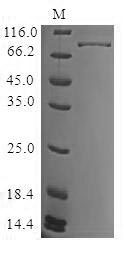The recombinant human tyrosine-protein kinase BTK was produced using a baculovirus system. The gene encoding the 1- 659aa of the human BTK was co-integrated into a plasmid with the N-terminal 10xHis-tag gene and then transfected into the baculovirus system for protein expression. The recombinant human BTK was purified from the cell lysate of the transfected baculovirus through affinity chromatography. Its purity is greater than 90% as determined by SDS-PAGE.
BTK is a cytoplasmic protein tyrosine kinase crucial for various cellular processes, especially in B cell development, activation, and survival [1]. It is expressed in B lymphocytes, myeloid cells, lung, and pancreas, but not in the T cell lineage [2]. BTK is expressed throughout B cell differentiation, from early precursor B cell to mature B cell stages [2]. The Btk-SH3 domain-binding protein Sab negatively regulates BTK [3]. It is also involved in apoptosis regulation and JNK/SAPK kinase activity [4].
References:
[1] B. Duriez, P. Duquesnoy, F. Dastot, P. Bougnères, S. Amselem, & M. Goossens, An exon‐skipping mutation in thebtk gene of a patient with x‐linked agammaglobulinemia and isolated growth hormone deficiency, Febs Letters, vol. 346, no. 2-3, p. 165-170, 1994. https://doi.org/10.1016/0014-5793(94)00457-9
[2] Y. Kawakami, T. Miura, R. Bissonnette, D. Hata, W. Khan, T. Kitamuraet al., Bruton’s tyrosine kinase regulates apoptosis and jnk/sapk kinase activity, Proceedings of the National Academy of Sciences, vol. 94, no. 8, p. 3938-3942, 1997. https://doi.org/10.1073/pnas.94.8.3938
[3] J. Debnath, M. Chamorro, M. Czar, E. Schaeffer, M. Lenardo, H. Varmuset al., rlk/txk encodes two forms of a novel cysteine string tyrosine kinase activated by src family kinases, Molecular and Cellular Biology, vol. 19, no. 2, p. 1498-1507, 1999. https://doi.org/10.1128/mcb.19.2.1498
[4] S. Guo, M. Wahl, & O. Witte, Mutational analysis of the sh2-kinase linker region of bruton's tyrosine kinase defines alternative modes of regulation for cytoplasmic tyrosine kinase families, International Immunology, vol. 18, no. 1, p. 79-87, 2005. https://doi.org/10.1093/intimm/dxh351z






